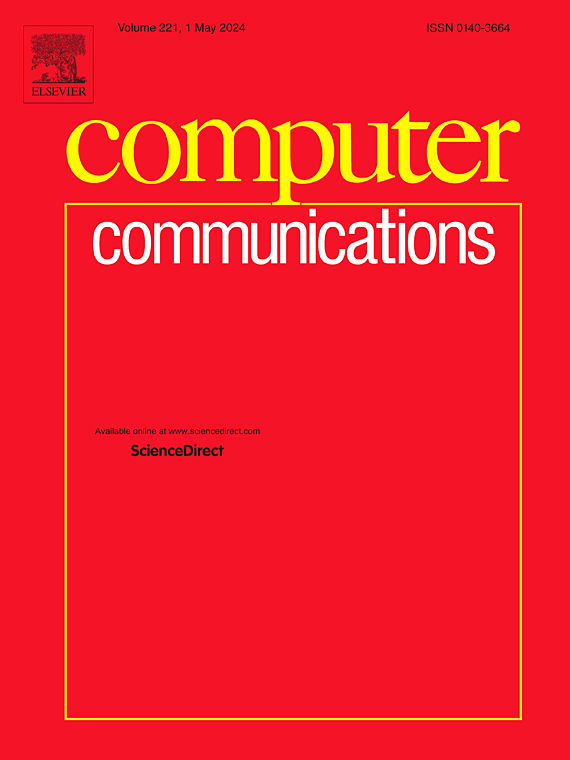GDD-Geo: IPv6 geolocation by graph dual decomposition
IF 4.5
3区 计算机科学
Q1 COMPUTER SCIENCE, INFORMATION SYSTEMS
引用次数: 0
Abstract
IP geolocation is a technique used to infer the location of an IP address through its network measurement features. It is widely used in network security, network management, and location-based services. To improve geolocation accuracy in IPv6 networks, especially when landmarks are sparse, we propose an IPv6 geolocation method based on graph dual decomposition called GDD-Geo. GDD-Geo models an IPv6 address by its network measurement attributes, including paths, delay values, and addresses. The geolocation process involves comparing the similarity of these attributes. GDD-Geo comprises two sub-algorithms, GDD-CGeo and GDD-SGeo, which provide city-level and street-level (oriented) geolocation results, respectively. Particularly, we design two graph decomposition algorithms to transform the paths represented by router interfaces into the paths represented by subgraphs based on the characteristics of IPv6 address distribution and delay distribution. The former decomposition is the support for GDD-CGeo, while the latter decomposition is conducted on the results of the former decomposition and supports GDD-SGeo. Due to the aggregation and reconstruction effects of paths derived from graph decomposition, GDD-Geo can reduce the dependence on landmarks and thus can cope with the landmark-sparse scenarios. Experimental results of city-level geolocation show that GDD-CGeo can accurately geolocate the IPv6 targets at the city level. Street-level (oriented) geolocation results in six cities within different countries show that the median errors of GDD-SGeo are 1.66–5.27 km, and the mean errors are 2.55–5.88 km. Compared with popular algorithms SLG and MLP-Geo, GDD-SGeo performs significantly better on sparse landmark datasets, with at least a 60% decrease in errors.

GDD-Geo:基于图对偶分解的IPv6地理定位
IP地理定位是一种通过网络测量特征推断IP地址所在位置的技术。它广泛应用于网络安全、网络管理和基于位置的业务。为了提高IPv6网络中的地理定位精度,特别是当地标稀疏时,我们提出了一种基于图对偶分解的IPv6地理定位方法GDD-Geo。GDD-Geo根据IPv6地址的网络测量属性(包括路径、时延值和地址)对IPv6地址进行建模。地理定位过程包括比较这些属性的相似性。GDD-Geo包括两个子算法GDD-CGeo和GDD-SGeo,分别提供城市级和街道级(面向)的地理定位结果。特别地,根据IPv6地址分布和时延分布的特点,设计了两种图分解算法,将路由器接口表示的路径转换为子图表示的路径。前一种分解是对GDD-CGeo的支持,后一种分解是在前一种分解结果的基础上进行的,支持GDD-SGeo。GDD-Geo通过图分解得到的路径的聚集和重建效果,减少了对地标的依赖,从而可以应对地标稀疏的场景。城市级地理定位实验结果表明,GDD-CGeo能够准确定位城市级IPv6目标。在不同国家6个城市的街道定位结果表明,GDD-SGeo的中位数误差为1.66 ~ 5.27 km,平均误差为2.55 ~ 5.88 km。与常用算法SLG和MLP-Geo相比,GDD-SGeo在稀疏地标数据集上的性能明显更好,误差至少降低了60%。
本文章由计算机程序翻译,如有差异,请以英文原文为准。
求助全文
约1分钟内获得全文
求助全文
来源期刊

Computer Communications
工程技术-电信学
CiteScore
14.10
自引率
5.00%
发文量
397
审稿时长
66 days
期刊介绍:
Computer and Communications networks are key infrastructures of the information society with high socio-economic value as they contribute to the correct operations of many critical services (from healthcare to finance and transportation). Internet is the core of today''s computer-communication infrastructures. This has transformed the Internet, from a robust network for data transfer between computers, to a global, content-rich, communication and information system where contents are increasingly generated by the users, and distributed according to human social relations. Next-generation network technologies, architectures and protocols are therefore required to overcome the limitations of the legacy Internet and add new capabilities and services. The future Internet should be ubiquitous, secure, resilient, and closer to human communication paradigms.
Computer Communications is a peer-reviewed international journal that publishes high-quality scientific articles (both theory and practice) and survey papers covering all aspects of future computer communication networks (on all layers, except the physical layer), with a special attention to the evolution of the Internet architecture, protocols, services, and applications.
 求助内容:
求助内容: 应助结果提醒方式:
应助结果提醒方式:


